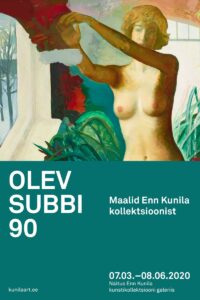7 March 2020 marked the passing of 90 years since the birth of the painter Olev Subbi. On this occasion, the artist’s close relatives, friends and admirers of his work gathered in Enn Kunila’s art collection gallery to remember Subbi in the midst of poetry and music, and to enjoy his richly colourful paintings, which radiate beauty, harmony and yearning.
‘Olev Subbi said that birthdays aren’t moving holidays and that’s the reason why we’ve gathered today in the midst of his works,’ said Enn Kunila at the opening of the exhibition. ‘It’s a great privilege to live among Olev Subbi’s paintings. This is art that I love very much and enjoy, and which has fascinated me for decades. Olev was always happy when he was talking about art and it’s precisely that joy that I’ve learned from him. I’ll never forget those years and my friendship with Olev Subbi.’ Lovely violin sounds as performed by Mari Poll resounded at the opening of the exhibition, along with the poetry of Marie Under as presented by Kersti Kreismann.
Forty paintings by Olev Subbi from all of his creative periods belong to Enn Kunila’s art collection. Thirty-five paintings are on display at the exhibition.
Olev Subbi and Enn Kunila shared a close friendship that began at the start of the 1990s and lasted for around twenty years until the artist passed away in 2013. Subbi’s advice on supplementing Kunila’s collection with works from older Estonian paintings augmented their conversations on art over time, as did joint trips to different art museums throughout the world, and amateur painting camps that they organised together in Hiiumaa.
Eero Epner has written in the catalogue that accompanies the exhibition:
‘When looking at Subbi’s works, the viewer is led into ideal environments, where principles and ideals chosen by Subbi apply, yet which aspire so uncompromisingly towards the absolute that agreeing with or rejecting those ideals becomes irrelevant. We see in Olev Subbi’s paintings one person’s continuous quest for ideals that has lasted for decades, uninterrupted movement from painting to painting that could be described as his life’s purpose or even its nucleus. Hence it is no wonder that in his life, Olev Subbi’s works were not a secondary project for him, but rather life’s only imaginable form of expression. The way Subbi painted was also the way he wanted to live.’
